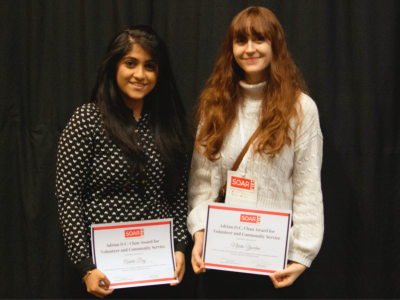–The following story is written by Mitch Jackson
Colour blindness is a condition that affects millions of people in North America. Graduate student Daniela Napoli hopes to discover what accessibility measures may be needed to accommodate colour-blind individuals, specifically in regards to online gaming.
“We see it everywhere we go. Colours have significant meanings,” explained Napoli.
“We wear black to a formal event, and bright yellow on a fun day at the beach.”
Napoli is in the first year of the master’s program in Human-Computer Interaction here at Carleton.
Her research demonstrates that colours are not just relevant in these real-life situations. They also serve important functions online.
Specifically in interface design, colours are important in delivering information and cuing users to complete certain tasks.
This presents a challenge to colour-blind individuals trying to navigate these online interfaces.
Napoli explained: “Previous research demonstrates that certain colours, like red, can influence our brains to be more alert and focused while playing games. The colours in game interfaces can essentially help us make snap decisions and better choices.”
“But, do colour-blind individuals experience these benefits in the same way? My research hopes to shine some light on this question.”
In her study, Napoli asked participants to play a simple puzzle game on a PC in its original state and then again with a colour-blind filter applied.
In its original state, the game’s interface was colour-coded to help organize blocks on the screen. The players said these colours helped them strategize during the game without thinking too hard.
However, in the colour-blind filter, the interface changed drastically. Everything was colour coded in the same shade of yellow or blue. Players said they were less comfortable and confident while playing with this filter.
“When comparing their performance between states, the results showed that the colour-blind filter had very little negative effect on player performance. In fact, these players performed better during the second session,” said Napoli.
Napoli hopes to undertake another study to see if these seemingly contradictory results will still occur and, if they continue to do so, to see why colour-blindness does not seem to impede gameplay.
This research is not all fun and games however, as the consequences have very real connections to the increasing importance of accessibility in technology development.
Napoli has previously worked in web development and became acquainted with Web Content Accessibility Guidelines (WCAG) and other best practices that are becoming legally mandated across Ontario.
“Since accessibility guidelines are made for people, not robots, I wanted to explore the human-side of these regulations,” said Napoli regarding her motivation to undertake the HCI program at Carleton. “Since working with accessibility best practices, I’ve had the chance to meet visually-impaired computer users. These individuals have shown me that optimized websites can make or break their independence. Once I learned this importance, I knew I had to come to Carleton to learn how I can add to the realm of accessible technology,” said Napoli.

Dr. Sonia Chaisson
What has impressed Napoli the most about the HCI program so far is the people that she has met, who share her interests, and challenge each other to think critically.
Napoli is also appreciative of the faculty and resources.
“Research like my colour-blind study could not have been easily done without the help of Dr. Sonia Chiasson and the CHORUS Lab.”
Monday, February 6, 2017 in Grad Student Research, News
Share: Twitter, Facebook




